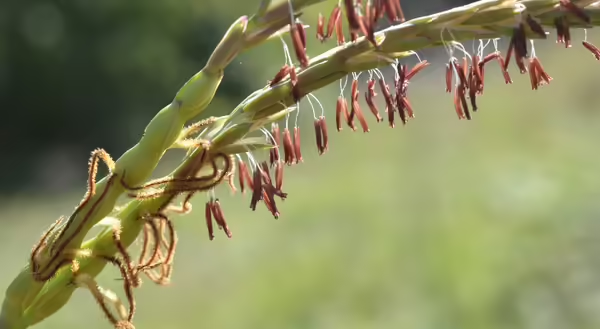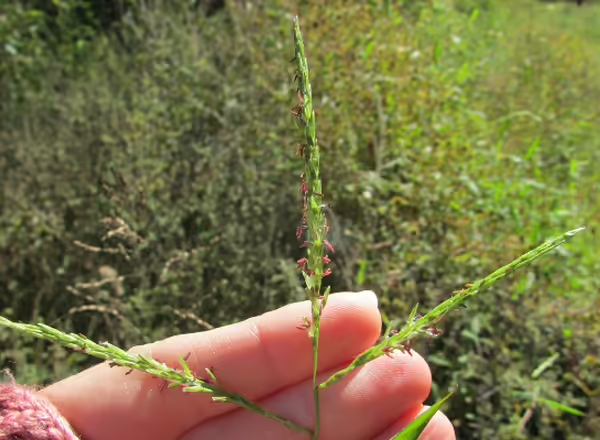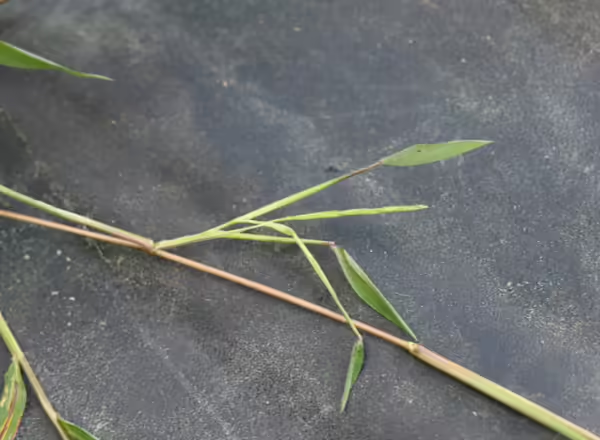
It’s difficult not to notice grasses at this time of year – all of the large warm-season grasses seem to be in bloom. Have you taken a closer look at grass flowers? They are amazing to see in bloom, when the anthers and stigmas are visible. Grasses, as you may know, are wind pollinated.
Unlike many of our other flowering species that are insect pollinated, wind pollinated plants hedge their bets by producing mass quantities of pollen in the hopes that some of it makes its way where it needs to be. Other wind pollinated plants include many of our tree species like maples, cottonwoods, and oaks, as well as giant ragweed, the source of many people’s fall allergies. These plants put their energy into producing lots of pollen, rather than making attractive flowers to entice insects or other critters to come and move their pollen for them.
But even with this method of overloading their pollen production, successful reproduction is not guaranteed. Do grasses have a backup plan? In fact, many of them do!
Two types of flowers
Most grasses develop two different types of flowers – outcrossing, called chasmogamous flowers, and self-crossing, called cleistogamous flowers. Outcrossing flowers are not self-compatible, meaning pollen from these flowers cannot successfully pollinate their own flowers. But self-crossing flowers, as you may have guessed, are designed to be self-compatible. These flowers develop as a backup plan just in case the outcrossing flowers don’t do their job.
Take Deer Tongue Grass as an example. It is in the Dichanthelium genus, and these grasses are known for having both of these types of flowers. These are cool-season grasses, meaning they complete most of their growth in the spring, followed by flowering and setting seed. The first spikelets that they produce have chasmogamous flowers, those outcrossing flowers. But the grass doesn’t just stop there. After flowering and setting seed in the early summer, Deer Tongue Grass will continue to grow, producing offshoot branches that then develop cleistogamous, or those closed, self-crossing flowers. A lot of the time these spikelets are smaller in size and number, and aren’t even necessarily visible unless you peel back some leaves. While this backup plan can ensure seed production, limiting gene flow can be detrimental in the long run, so it’s good that grasses have both options to ensure successful seed production.
Why is this important?
First of all, I think it’s amazing to consider the several layers of security that these grasses, and plants in general, go through to protect their odds of successfully producing viable seed. But second, while this backup mechanism might sound like good news for desirable plants that we want to have around, some invasive species also produce both types of flowers. That means even if you are able to disrupt their normal flowering cycle, they may still be able to produce their own self-crossing flowers and viable seed. Japanese Stiltgrass falls into this category – it produces both outcrossing and self-crossing flowers, so pay close attention if you are working to remove this grass. This means even if you don’t see it flowering, always make sure to bag up and discard the foliage, rather than pulling it and leaving it on site. There could be hidden seeds developing!


Never miss a new post! Sign up for our email list.
ABOUT THE AUTHOR: Erin Garrett is a Natural Resources, Environment, and Energy Educator for University of Illinois Extension serving Alexander, Johnson, Massac, Pulaski, and Union counties. Erin develops and delivers high impact programming to adults and youth to help them develop an appreciation for natural resources and to empower them to make small changes to positively impact the environment. Erin’s programming focuses on why homeowners should consider choosing native plants, how to support native pollinators, how to identify grasses, how to identify and manage invasive species, and developing an appreciation for prairie ecosystems.
ABOUT THE BLOG: Grasses at a Glance dives into grass identification, focusing on tips and tricks that make grass identification possible. Get information about native and non-native species, how to tell look-alikes apart, and which grasses you can find in Illinois.